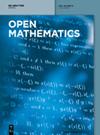求助PDF
{"title":"二维广义三角函数和双曲ρ凸函数的 Hermite-Hadamard 型不等式","authors":"Silvestru Sever Dragomir, Mohamed Jleli, Bessem Samet","doi":"10.1515/math-2024-0028","DOIUrl":null,"url":null,"abstract":"In this article, we establish Hermite-Hadamard-type inequalities for the two classes of functions <jats:inline-formula> <jats:alternatives> <jats:inline-graphic xmlns:xlink=\"http://www.w3.org/1999/xlink\" xlink:href=\"graphic/j_math-2024-0028_eq_002.png\"/> <m:math xmlns:m=\"http://www.w3.org/1998/Math/MathML\"> <m:msub> <m:mrow> <m:mi>X</m:mi> </m:mrow> <m:mrow> <m:mo>±</m:mo> <m:mi>λ</m:mi> </m:mrow> </m:msub> <m:mrow> <m:mo>(</m:mo> <m:mrow> <m:mi mathvariant=\"normal\">Ω</m:mi> </m:mrow> <m:mo>)</m:mo> </m:mrow> <m:mo>=</m:mo> <m:mrow> <m:mo stretchy=\"false\">{</m:mo> <m:mrow> <m:mi>f</m:mi> <m:mo>∈</m:mo> <m:msup> <m:mrow> <m:mi>C</m:mi> </m:mrow> <m:mrow> <m:mn>2</m:mn> </m:mrow> </m:msup> <m:mrow> <m:mo>(</m:mo> <m:mrow> <m:mi mathvariant=\"normal\">Ω</m:mi> </m:mrow> <m:mo>)</m:mo> </m:mrow> <m:mo>:</m:mo> <m:mi mathvariant=\"normal\">Δ</m:mi> <m:mi>f</m:mi> <m:mo>±</m:mo> <m:mi>λ</m:mi> <m:mi>f</m:mi> <m:mo>≥</m:mo> <m:mn>0</m:mn> </m:mrow> <m:mo stretchy=\"false\">}</m:mo> </m:mrow> </m:math> <jats:tex-math>{X}_{\\pm \\lambda }\\left(\\Omega )=\\{f\\in {C}^{2}\\left(\\Omega ):\\Delta f\\pm \\lambda f\\ge 0\\}</jats:tex-math> </jats:alternatives> </jats:inline-formula>, where <jats:inline-formula> <jats:alternatives> <jats:inline-graphic xmlns:xlink=\"http://www.w3.org/1999/xlink\" xlink:href=\"graphic/j_math-2024-0028_eq_003.png\"/> <m:math xmlns:m=\"http://www.w3.org/1998/Math/MathML\"> <m:mi>λ</m:mi> <m:mo>></m:mo> <m:mn>0</m:mn> </m:math> <jats:tex-math>\\lambda \\gt 0</jats:tex-math> </jats:alternatives> </jats:inline-formula> and <jats:inline-formula> <jats:alternatives> <jats:inline-graphic xmlns:xlink=\"http://www.w3.org/1999/xlink\" xlink:href=\"graphic/j_math-2024-0028_eq_004.png\"/> <m:math xmlns:m=\"http://www.w3.org/1998/Math/MathML\"> <m:mi mathvariant=\"normal\">Ω</m:mi> </m:math> <jats:tex-math>\\Omega </jats:tex-math> </jats:alternatives> </jats:inline-formula> is an open subset of <jats:inline-formula> <jats:alternatives> <jats:inline-graphic xmlns:xlink=\"http://www.w3.org/1999/xlink\" xlink:href=\"graphic/j_math-2024-0028_eq_005.png\"/> <m:math xmlns:m=\"http://www.w3.org/1998/Math/MathML\"> <m:msup> <m:mrow> <m:mi mathvariant=\"double-struck\">R</m:mi> </m:mrow> <m:mrow> <m:mn>2</m:mn> </m:mrow> </m:msup> </m:math> <jats:tex-math>{{\\mathbb{R}}}^{2}</jats:tex-math> </jats:alternatives> </jats:inline-formula>. We also obtain a characterization of the set <jats:inline-formula> <jats:alternatives> <jats:inline-graphic xmlns:xlink=\"http://www.w3.org/1999/xlink\" xlink:href=\"graphic/j_math-2024-0028_eq_006.png\"/> <m:math xmlns:m=\"http://www.w3.org/1998/Math/MathML\"> <m:msub> <m:mrow> <m:mi>X</m:mi> </m:mrow> <m:mrow> <m:mo>−</m:mo> <m:mi>λ</m:mi> </m:mrow> </m:msub> <m:mrow> <m:mo>(</m:mo> <m:mrow> <m:mi mathvariant=\"normal\">Ω</m:mi> </m:mrow> <m:mo>)</m:mo> </m:mrow> </m:math> <jats:tex-math>{X}_{-\\lambda }\\left(\\Omega )</jats:tex-math> </jats:alternatives> </jats:inline-formula>. Notice that in the one-dimensional case, if <jats:inline-formula> <jats:alternatives> <jats:inline-graphic xmlns:xlink=\"http://www.w3.org/1999/xlink\" xlink:href=\"graphic/j_math-2024-0028_eq_007.png\"/> <m:math xmlns:m=\"http://www.w3.org/1998/Math/MathML\"> <m:mi mathvariant=\"normal\">Ω</m:mi> <m:mo>=</m:mo> <m:mi>I</m:mi> </m:math> <jats:tex-math>\\Omega =I</jats:tex-math> </jats:alternatives> </jats:inline-formula> (an open interval of <jats:inline-formula> <jats:alternatives> <jats:inline-graphic xmlns:xlink=\"http://www.w3.org/1999/xlink\" xlink:href=\"graphic/j_math-2024-0028_eq_008.png\"/> <m:math xmlns:m=\"http://www.w3.org/1998/Math/MathML\"> <m:mi mathvariant=\"double-struck\">R</m:mi> </m:math> <jats:tex-math>{\\mathbb{R}}</jats:tex-math> </jats:alternatives> </jats:inline-formula>) and <jats:inline-formula> <jats:alternatives> <jats:inline-graphic xmlns:xlink=\"http://www.w3.org/1999/xlink\" xlink:href=\"graphic/j_math-2024-0028_eq_009.png\"/> <m:math xmlns:m=\"http://www.w3.org/1998/Math/MathML\"> <m:mi>λ</m:mi> <m:mo>=</m:mo> <m:msup> <m:mrow> <m:mi>ρ</m:mi> </m:mrow> <m:mrow> <m:mn>2</m:mn> </m:mrow> </m:msup> </m:math> <jats:tex-math>\\lambda ={\\rho }^{2}</jats:tex-math> </jats:alternatives> </jats:inline-formula>, <jats:inline-formula> <jats:alternatives> <jats:inline-graphic xmlns:xlink=\"http://www.w3.org/1999/xlink\" xlink:href=\"graphic/j_math-2024-0028_eq_010.png\"/> <m:math xmlns:m=\"http://www.w3.org/1998/Math/MathML\"> <m:mi>ρ</m:mi> <m:mo>></m:mo> <m:mn>0</m:mn> </m:math> <jats:tex-math>\\rho \\gt 0</jats:tex-math> </jats:alternatives> </jats:inline-formula>, then <jats:inline-formula> <jats:alternatives> <jats:inline-graphic xmlns:xlink=\"http://www.w3.org/1999/xlink\" xlink:href=\"graphic/j_math-2024-0028_eq_011.png\"/> <m:math xmlns:m=\"http://www.w3.org/1998/Math/MathML\"> <m:msub> <m:mrow> <m:mi>X</m:mi> </m:mrow> <m:mrow> <m:mi>λ</m:mi> </m:mrow> </m:msub> <m:mrow> <m:mo>(</m:mo> <m:mrow> <m:mi mathvariant=\"normal\">Ω</m:mi> </m:mrow> <m:mo>)</m:mo> </m:mrow> </m:math> <jats:tex-math>{X}_{\\lambda }\\left(\\Omega )</jats:tex-math> </jats:alternatives> </jats:inline-formula> (resp. <jats:inline-formula> <jats:alternatives> <jats:inline-graphic xmlns:xlink=\"http://www.w3.org/1999/xlink\" xlink:href=\"graphic/j_math-2024-0028_eq_012.png\"/> <m:math xmlns:m=\"http://www.w3.org/1998/Math/MathML\"> <m:msub> <m:mrow> <m:mi>X</m:mi> </m:mrow> <m:mrow> <m:mo>−</m:mo> <m:mi>λ</m:mi> </m:mrow> </m:msub> <m:mrow> <m:mo>(</m:mo> <m:mrow> <m:mi mathvariant=\"normal\">Ω</m:mi> </m:mrow> <m:mo>)</m:mo> </m:mrow> </m:math> <jats:tex-math>{X}_{-\\lambda }\\left(\\Omega )</jats:tex-math> </jats:alternatives> </jats:inline-formula>) reduces to the class of functions <jats:inline-formula> <jats:alternatives> <jats:inline-graphic xmlns:xlink=\"http://www.w3.org/1999/xlink\" xlink:href=\"graphic/j_math-2024-0028_eq_013.png\"/> <m:math xmlns:m=\"http://www.w3.org/1998/Math/MathML\"> <m:mi>f</m:mi> <m:mo>∈</m:mo> <m:msup> <m:mrow> <m:mi>C</m:mi> </m:mrow> <m:mrow> <m:mn>2</m:mn> </m:mrow> </m:msup> <m:mrow> <m:mo>(</m:mo> <m:mrow> <m:mi>I</m:mi> </m:mrow> <m:mo>)</m:mo> </m:mrow> </m:math> <jats:tex-math>f\\in {C}^{2}\\left(I)</jats:tex-math> </jats:alternatives> </jats:inline-formula> such that <jats:inline-formula> <jats:alternatives> <jats:inline-graphic xmlns:xlink=\"http://www.w3.org/1999/xlink\" xlink:href=\"graphic/j_math-2024-0028_eq_014.png\"/> <m:math xmlns:m=\"http://www.w3.org/1998/Math/MathML\"> <m:mi>f</m:mi> </m:math> <jats:tex-math>f</jats:tex-math> </jats:alternatives> </jats:inline-formula> is trigonometrically <jats:inline-formula> <jats:alternatives> <jats:inline-graphic xmlns:xlink=\"http://www.w3.org/1999/xlink\" xlink:href=\"graphic/j_math-2024-0028_eq_015.png\"/> <m:math xmlns:m=\"http://www.w3.org/1998/Math/MathML\"> <m:mi>ρ</m:mi> </m:math> <jats:tex-math>\\rho </jats:tex-math> </jats:alternatives> </jats:inline-formula>-convex (resp. hyperbolic <jats:inline-formula> <jats:alternatives> <jats:inline-graphic xmlns:xlink=\"http://www.w3.org/1999/xlink\" xlink:href=\"graphic/j_math-2024-0028_eq_016.png\"/> <m:math xmlns:m=\"http://www.w3.org/1998/Math/MathML\"> <m:mi>ρ</m:mi> </m:math> <jats:tex-math>\\rho </jats:tex-math> </jats:alternatives> </jats:inline-formula>-convex) on <jats:inline-formula> <jats:alternatives> <jats:inline-graphic xmlns:xlink=\"http://www.w3.org/1999/xlink\" xlink:href=\"graphic/j_math-2024-0028_eq_017.png\"/> <m:math xmlns:m=\"http://www.w3.org/1998/Math/MathML\"> <m:mi>I</m:mi> </m:math> <jats:tex-math>I</jats:tex-math> </jats:alternatives> </jats:inline-formula>.","PeriodicalId":48713,"journal":{"name":"Open Mathematics","volume":"53 1","pages":""},"PeriodicalIF":1.0000,"publicationDate":"2024-08-02","publicationTypes":"Journal Article","fieldsOfStudy":null,"isOpenAccess":false,"openAccessPdf":"","citationCount":"0","resultStr":"{\"title\":\"Hermite-Hadamard-type inequalities for generalized trigonometrically and hyperbolic ρ-convex functions in two dimension\",\"authors\":\"Silvestru Sever Dragomir, Mohamed Jleli, Bessem Samet\",\"doi\":\"10.1515/math-2024-0028\",\"DOIUrl\":null,\"url\":null,\"abstract\":\"In this article, we establish Hermite-Hadamard-type inequalities for the two classes of functions <jats:inline-formula> <jats:alternatives> <jats:inline-graphic xmlns:xlink=\\\"http://www.w3.org/1999/xlink\\\" xlink:href=\\\"graphic/j_math-2024-0028_eq_002.png\\\"/> <m:math xmlns:m=\\\"http://www.w3.org/1998/Math/MathML\\\"> <m:msub> <m:mrow> <m:mi>X</m:mi> </m:mrow> <m:mrow> <m:mo>±</m:mo> <m:mi>λ</m:mi> </m:mrow> </m:msub> <m:mrow> <m:mo>(</m:mo> <m:mrow> <m:mi mathvariant=\\\"normal\\\">Ω</m:mi> </m:mrow> <m:mo>)</m:mo> </m:mrow> <m:mo>=</m:mo> <m:mrow> <m:mo stretchy=\\\"false\\\">{</m:mo> <m:mrow> <m:mi>f</m:mi> <m:mo>∈</m:mo> <m:msup> <m:mrow> <m:mi>C</m:mi> </m:mrow> <m:mrow> <m:mn>2</m:mn> </m:mrow> </m:msup> <m:mrow> <m:mo>(</m:mo> <m:mrow> <m:mi mathvariant=\\\"normal\\\">Ω</m:mi> </m:mrow> <m:mo>)</m:mo> </m:mrow> <m:mo>:</m:mo> <m:mi mathvariant=\\\"normal\\\">Δ</m:mi> <m:mi>f</m:mi> <m:mo>±</m:mo> <m:mi>λ</m:mi> <m:mi>f</m:mi> <m:mo>≥</m:mo> <m:mn>0</m:mn> </m:mrow> <m:mo stretchy=\\\"false\\\">}</m:mo> </m:mrow> </m:math> <jats:tex-math>{X}_{\\\\pm \\\\lambda }\\\\left(\\\\Omega )=\\\\{f\\\\in {C}^{2}\\\\left(\\\\Omega ):\\\\Delta f\\\\pm \\\\lambda f\\\\ge 0\\\\}</jats:tex-math> </jats:alternatives> </jats:inline-formula>, where <jats:inline-formula> <jats:alternatives> <jats:inline-graphic xmlns:xlink=\\\"http://www.w3.org/1999/xlink\\\" xlink:href=\\\"graphic/j_math-2024-0028_eq_003.png\\\"/> <m:math xmlns:m=\\\"http://www.w3.org/1998/Math/MathML\\\"> <m:mi>λ</m:mi> <m:mo>></m:mo> <m:mn>0</m:mn> </m:math> <jats:tex-math>\\\\lambda \\\\gt 0</jats:tex-math> </jats:alternatives> </jats:inline-formula> and <jats:inline-formula> <jats:alternatives> <jats:inline-graphic xmlns:xlink=\\\"http://www.w3.org/1999/xlink\\\" xlink:href=\\\"graphic/j_math-2024-0028_eq_004.png\\\"/> <m:math xmlns:m=\\\"http://www.w3.org/1998/Math/MathML\\\"> <m:mi mathvariant=\\\"normal\\\">Ω</m:mi> </m:math> <jats:tex-math>\\\\Omega </jats:tex-math> </jats:alternatives> </jats:inline-formula> is an open subset of <jats:inline-formula> <jats:alternatives> <jats:inline-graphic xmlns:xlink=\\\"http://www.w3.org/1999/xlink\\\" xlink:href=\\\"graphic/j_math-2024-0028_eq_005.png\\\"/> <m:math xmlns:m=\\\"http://www.w3.org/1998/Math/MathML\\\"> <m:msup> <m:mrow> <m:mi mathvariant=\\\"double-struck\\\">R</m:mi> </m:mrow> <m:mrow> <m:mn>2</m:mn> </m:mrow> </m:msup> </m:math> <jats:tex-math>{{\\\\mathbb{R}}}^{2}</jats:tex-math> </jats:alternatives> </jats:inline-formula>. We also obtain a characterization of the set <jats:inline-formula> <jats:alternatives> <jats:inline-graphic xmlns:xlink=\\\"http://www.w3.org/1999/xlink\\\" xlink:href=\\\"graphic/j_math-2024-0028_eq_006.png\\\"/> <m:math xmlns:m=\\\"http://www.w3.org/1998/Math/MathML\\\"> <m:msub> <m:mrow> <m:mi>X</m:mi> </m:mrow> <m:mrow> <m:mo>−</m:mo> <m:mi>λ</m:mi> </m:mrow> </m:msub> <m:mrow> <m:mo>(</m:mo> <m:mrow> <m:mi mathvariant=\\\"normal\\\">Ω</m:mi> </m:mrow> <m:mo>)</m:mo> </m:mrow> </m:math> <jats:tex-math>{X}_{-\\\\lambda }\\\\left(\\\\Omega )</jats:tex-math> </jats:alternatives> </jats:inline-formula>. Notice that in the one-dimensional case, if <jats:inline-formula> <jats:alternatives> <jats:inline-graphic xmlns:xlink=\\\"http://www.w3.org/1999/xlink\\\" xlink:href=\\\"graphic/j_math-2024-0028_eq_007.png\\\"/> <m:math xmlns:m=\\\"http://www.w3.org/1998/Math/MathML\\\"> <m:mi mathvariant=\\\"normal\\\">Ω</m:mi> <m:mo>=</m:mo> <m:mi>I</m:mi> </m:math> <jats:tex-math>\\\\Omega =I</jats:tex-math> </jats:alternatives> </jats:inline-formula> (an open interval of <jats:inline-formula> <jats:alternatives> <jats:inline-graphic xmlns:xlink=\\\"http://www.w3.org/1999/xlink\\\" xlink:href=\\\"graphic/j_math-2024-0028_eq_008.png\\\"/> <m:math xmlns:m=\\\"http://www.w3.org/1998/Math/MathML\\\"> <m:mi mathvariant=\\\"double-struck\\\">R</m:mi> </m:math> <jats:tex-math>{\\\\mathbb{R}}</jats:tex-math> </jats:alternatives> </jats:inline-formula>) and <jats:inline-formula> <jats:alternatives> <jats:inline-graphic xmlns:xlink=\\\"http://www.w3.org/1999/xlink\\\" xlink:href=\\\"graphic/j_math-2024-0028_eq_009.png\\\"/> <m:math xmlns:m=\\\"http://www.w3.org/1998/Math/MathML\\\"> <m:mi>λ</m:mi> <m:mo>=</m:mo> <m:msup> <m:mrow> <m:mi>ρ</m:mi> </m:mrow> <m:mrow> <m:mn>2</m:mn> </m:mrow> </m:msup> </m:math> <jats:tex-math>\\\\lambda ={\\\\rho }^{2}</jats:tex-math> </jats:alternatives> </jats:inline-formula>, <jats:inline-formula> <jats:alternatives> <jats:inline-graphic xmlns:xlink=\\\"http://www.w3.org/1999/xlink\\\" xlink:href=\\\"graphic/j_math-2024-0028_eq_010.png\\\"/> <m:math xmlns:m=\\\"http://www.w3.org/1998/Math/MathML\\\"> <m:mi>ρ</m:mi> <m:mo>></m:mo> <m:mn>0</m:mn> </m:math> <jats:tex-math>\\\\rho \\\\gt 0</jats:tex-math> </jats:alternatives> </jats:inline-formula>, then <jats:inline-formula> <jats:alternatives> <jats:inline-graphic xmlns:xlink=\\\"http://www.w3.org/1999/xlink\\\" xlink:href=\\\"graphic/j_math-2024-0028_eq_011.png\\\"/> <m:math xmlns:m=\\\"http://www.w3.org/1998/Math/MathML\\\"> <m:msub> <m:mrow> <m:mi>X</m:mi> </m:mrow> <m:mrow> <m:mi>λ</m:mi> </m:mrow> </m:msub> <m:mrow> <m:mo>(</m:mo> <m:mrow> <m:mi mathvariant=\\\"normal\\\">Ω</m:mi> </m:mrow> <m:mo>)</m:mo> </m:mrow> </m:math> <jats:tex-math>{X}_{\\\\lambda }\\\\left(\\\\Omega )</jats:tex-math> </jats:alternatives> </jats:inline-formula> (resp. <jats:inline-formula> <jats:alternatives> <jats:inline-graphic xmlns:xlink=\\\"http://www.w3.org/1999/xlink\\\" xlink:href=\\\"graphic/j_math-2024-0028_eq_012.png\\\"/> <m:math xmlns:m=\\\"http://www.w3.org/1998/Math/MathML\\\"> <m:msub> <m:mrow> <m:mi>X</m:mi> </m:mrow> <m:mrow> <m:mo>−</m:mo> <m:mi>λ</m:mi> </m:mrow> </m:msub> <m:mrow> <m:mo>(</m:mo> <m:mrow> <m:mi mathvariant=\\\"normal\\\">Ω</m:mi> </m:mrow> <m:mo>)</m:mo> </m:mrow> </m:math> <jats:tex-math>{X}_{-\\\\lambda }\\\\left(\\\\Omega )</jats:tex-math> </jats:alternatives> </jats:inline-formula>) reduces to the class of functions <jats:inline-formula> <jats:alternatives> <jats:inline-graphic xmlns:xlink=\\\"http://www.w3.org/1999/xlink\\\" xlink:href=\\\"graphic/j_math-2024-0028_eq_013.png\\\"/> <m:math xmlns:m=\\\"http://www.w3.org/1998/Math/MathML\\\"> <m:mi>f</m:mi> <m:mo>∈</m:mo> <m:msup> <m:mrow> <m:mi>C</m:mi> </m:mrow> <m:mrow> <m:mn>2</m:mn> </m:mrow> </m:msup> <m:mrow> <m:mo>(</m:mo> <m:mrow> <m:mi>I</m:mi> </m:mrow> <m:mo>)</m:mo> </m:mrow> </m:math> <jats:tex-math>f\\\\in {C}^{2}\\\\left(I)</jats:tex-math> </jats:alternatives> </jats:inline-formula> such that <jats:inline-formula> <jats:alternatives> <jats:inline-graphic xmlns:xlink=\\\"http://www.w3.org/1999/xlink\\\" xlink:href=\\\"graphic/j_math-2024-0028_eq_014.png\\\"/> <m:math xmlns:m=\\\"http://www.w3.org/1998/Math/MathML\\\"> <m:mi>f</m:mi> </m:math> <jats:tex-math>f</jats:tex-math> </jats:alternatives> </jats:inline-formula> is trigonometrically <jats:inline-formula> <jats:alternatives> <jats:inline-graphic xmlns:xlink=\\\"http://www.w3.org/1999/xlink\\\" xlink:href=\\\"graphic/j_math-2024-0028_eq_015.png\\\"/> <m:math xmlns:m=\\\"http://www.w3.org/1998/Math/MathML\\\"> <m:mi>ρ</m:mi> </m:math> <jats:tex-math>\\\\rho </jats:tex-math> </jats:alternatives> </jats:inline-formula>-convex (resp. hyperbolic <jats:inline-formula> <jats:alternatives> <jats:inline-graphic xmlns:xlink=\\\"http://www.w3.org/1999/xlink\\\" xlink:href=\\\"graphic/j_math-2024-0028_eq_016.png\\\"/> <m:math xmlns:m=\\\"http://www.w3.org/1998/Math/MathML\\\"> <m:mi>ρ</m:mi> </m:math> <jats:tex-math>\\\\rho </jats:tex-math> </jats:alternatives> </jats:inline-formula>-convex) on <jats:inline-formula> <jats:alternatives> <jats:inline-graphic xmlns:xlink=\\\"http://www.w3.org/1999/xlink\\\" xlink:href=\\\"graphic/j_math-2024-0028_eq_017.png\\\"/> <m:math xmlns:m=\\\"http://www.w3.org/1998/Math/MathML\\\"> <m:mi>I</m:mi> </m:math> <jats:tex-math>I</jats:tex-math> </jats:alternatives> </jats:inline-formula>.\",\"PeriodicalId\":48713,\"journal\":{\"name\":\"Open Mathematics\",\"volume\":\"53 1\",\"pages\":\"\"},\"PeriodicalIF\":1.0000,\"publicationDate\":\"2024-08-02\",\"publicationTypes\":\"Journal Article\",\"fieldsOfStudy\":null,\"isOpenAccess\":false,\"openAccessPdf\":\"\",\"citationCount\":\"0\",\"resultStr\":null,\"platform\":\"Semanticscholar\",\"paperid\":null,\"PeriodicalName\":\"Open Mathematics\",\"FirstCategoryId\":\"100\",\"ListUrlMain\":\"https://doi.org/10.1515/math-2024-0028\",\"RegionNum\":4,\"RegionCategory\":\"数学\",\"ArticlePicture\":[],\"TitleCN\":null,\"AbstractTextCN\":null,\"PMCID\":null,\"EPubDate\":\"\",\"PubModel\":\"\",\"JCR\":\"Q1\",\"JCRName\":\"MATHEMATICS\",\"Score\":null,\"Total\":0}","platform":"Semanticscholar","paperid":null,"PeriodicalName":"Open Mathematics","FirstCategoryId":"100","ListUrlMain":"https://doi.org/10.1515/math-2024-0028","RegionNum":4,"RegionCategory":"数学","ArticlePicture":[],"TitleCN":null,"AbstractTextCN":null,"PMCID":null,"EPubDate":"","PubModel":"","JCR":"Q1","JCRName":"MATHEMATICS","Score":null,"Total":0}
引用次数: 0
引用
批量引用


